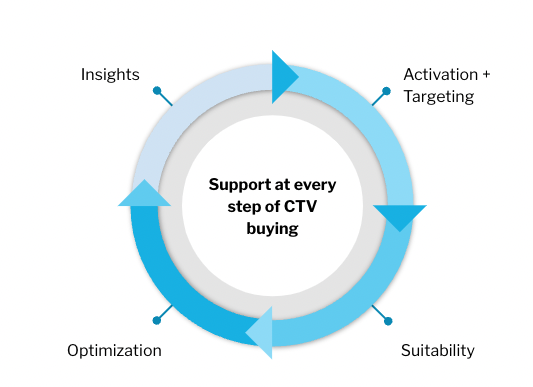Overcoming Challenges in Programmatic CTV Advertising: A Buyer's Guide
Programmatic buyers face unique challenges that can hinder the effectiveness of their CTV campaigns. The rigid structure of Private Marketplace (PMP)...

Programmatic advertising is a widely-used and fast-growing segment of digital marketing that uses automated tools and real-time bidding to purchase ad space online. Services like Google Marketing Platform, The Trade Desk, MediaMath, and more all allow advertisers to target and segment users based on specific demographics and behavior, and display ads to them across a range of content inventories.
Advertisers use programmatic ad buying techniques to automate the process of targeting and buying ad space online. By automating and speeding up this process, advertisers can target very specific audiences efficiently, and in real time.
Programmatic advertising emerged as a response to traditional advertising methods that were labor-intensive and time-consuming. By automating bidding, ad purchasing and, to some extent, targeting, programmatic minimizes human intervention for the sake of scale and efficiency.
Because of that efficiency and scale, the global programmatic display advertising marketing is projected to reach $2.772 trillion by 2028, with a 31.9% CAGR during that time period. This is primarily driven by the continued growth of digital content platforms, smart device usage, and the increasing digitalization of platforms to support programmatic display advertising.
It’s clear that programmatic advertising has enormous upside and reach in the digital marketing world. But that’s not to say that it doesn’t come with its own downsides. This article will balance the pros and cons of programmatic advertising, and offer tips and tools for getting the most out of this powerful digital marketing technique.
First, let’s step back and explain how programmatic advertising works in a nutshell.
As mentioned, programmatic advertising automates the ad buying process. Functionally, this begins at the demand side platform (DSP). This is where advertisers can set up campaigns, targeting parameters, and creative that will be displayed on inventory across a variety of ad exchanges, private marketplaces, open exchanges, and supply side platforms (SSPs). This could be websites, CTV applications or players, apps, and more.
Targeting through a DSP is based on either behavioral or contextual data about the user or ad inventory. For behavioral targeting, this includes data about user demographics, browsing behavior, interests, geography, and so on. For contextual data, targeting is based on the type of content that the advertising wants their ads to appear alongside.
Once targeting is specified, ads uploaded, and budget set, real-time bidding begins. From here, the programmatic platform bids on CPM, ad impressions and clicks in real-time based on the campaign objectives specified by the advertiser. This takes place automatically and at large scale, minimizing the need for manual interactions.
As mentioned, the core benefits of programmatic advertising relate to the speed, scale, and accuracy at which advertisers can reach the right audiences.
More specifically, here is a list of programmatic advertising benefits that illustrate why its experienced such growth in recent years:
Now that we’ve established the benefits of programmatic advertising, let's look at some cons.
Programmatic advertising can be an enormous cost center for businesses. Digital ad campaigns can start as low as $500 per month, and scale to a virtually limitless ceiling. Because of that, it’s critical that advertisers understand how programmatic works in great detail. This will ensure that they are able to closely control their ad spend and transparently manage their ROAS.
Understanding how programmatic advertising works means being eyes wide open about its benefits and its potential dangers.
To help with that, here’s a list of programmatic advertising cons that advertisers need to know about:
With a thorough understanding of programmatic advertising, however, ad managers can make informed decisions about ad placements, targeting strategies, and budget allocation. This starts with understanding the tools available to mitigate many of the challenges listed above.
To distill the points in this article so far, three of the biggest challenges associated with programmatic advertising today are:
Contextual targeting, layered with transparency and brand safety controls, is perhaps the most effective way to mitigate these challenges.
In a nutshell, contextual advertising serves users with targeted advertising based on terms they’ve recently entered into search engines or website or video content they’ve recently viewed. Tactically, targeting is based on specific contextual categories or keyword clusters that relate to the advertiser’s product or solutions offering. And those same keyword clusters and categories can be used as negative targeting attributes to ensure brand suitability.
By targeting contextually, advertisers can show their ad creatives alongside relevant content to people who have a demonstrable interest in that subject matter.
Through advanced algorithms, contextual technology is able to understand various factors like content on a webpage, local weather and postal code, and even recent news events. These platforms then use machine learning and natural language processing to classify a page in real time to ensure the right ad placements are displayed to the right users, at the right time.
As programmatic advertising becomes more complex, and third-party cookies decay, it will become harder and harder to track users across the internet. This, effectively, diminishes the efficacy of programmatic advertising. Contextual targeting provides a solution to that.
But while contextual targeting and categories offer a solution to decaying efficacy and brand safety issues associated with programmatic advertising, transparency remains an issue for some content inventories. Luckily, there are tools available to help with that too.
A recent study shows that 82% of TV households in the US have at least one connected TV device. But while connected TV is both one of the fastest growing online content segments for programmatic advertisers, there is a significant lack of transparency into where CTV ads run and how they perform.
Some common challenges associated with reporting for CTV programmatic campaigns include:
All of this means that advertisers are effectively spending blind on CTV ad networks. It may be possible that the quality programming they think they’re paying for is actually something as low quality as a screensaver. The problem is that it’s hard to know. And, because of that, it’s also very hard to control.

Peer39’s CTV transparency reporting tool aims to fix that. With it, advertisers can now generate CTV reports that offer the following insights for each campaign:
With this reporting, programmatic advertisers now have the insights they need to make informed targeting and budgeting decisions for their CTV media buying. One less headache when navigating the complex world of programmatic media advertising.

Programmatic buyers face unique challenges that can hinder the effectiveness of their CTV campaigns. The rigid structure of Private Marketplace (PMP)...

1 min read
Understanding the ins-and-outs of pre-bid programmatic advertising can be a challenge. With such a rapidly changing data landscape, and the coming...

1 min read
In just two decades, there have been drastic changes to how consumers access entertainment. It wasn’t that long ago when pay television was the new...